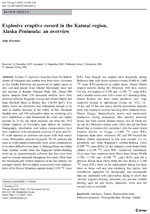Mageik Thick Orange Tan Ash
Start: 9260 yBP [1]
Event Type: Explosive
- Tephrafall [1]
Description: From Fierstein (2007): "The oldest flows from East Mageik (unit "meo" of Hildreth and Fierstein 2003) have more degraded surfaces than their younger counterparts, although they are not obviously ice-scoured...Tephra deposits possibly associated with this eruptive episode are three older ash layers identified in the Angle Creek key section: the bluish-grey ash (just below K-2500G: ∼6,000-6,700 14C years B.P.), the thick gritty salmon ash (K-2500E: underlying peat is 8430+/-115 14C years B.P.) and the thick orange-tan ash (K-2500B: ∼9,260 14C years B.P.). Glass shards from the thick gritty salmon ash span a wider SiO2 range (74-78 wt.%) than those from the bluish-grey and the thick orange-tan (74-76 wt.%) ashes, while oxide data for all three ash layers overlap (Fig. 23 [in original text]). Microprobe data for these ash layers are so similar to those from younger East Mageik tephra that I am fairly confident they, too, are from East Mageik. The total eruptive volume of the East Mageik lavas is 5-6 km3, to which the dacitic falls and one small andesitic pyroclastic-flow deposit preserved locally atop "meo" add no more than 0.1 km3 (Hildreth and Fierstein 2000). Thus, over a period of ∼7,000 years, the preserved tephra record suggests there may have been at least six eruptive episodes from East Mageik plus one phreatic event, each separated by as little as 100 years to as much as 2,700 years."
"A 4 to 6-cm thick light orange-tan ash stands out sharply near the base of this section in Angle Creek (K-2500B, Fig. 3 [in original text]). Very fine-grained (Md=0.09 mm), it lies 10 cm beneath the greenish-brown ash and has no correlatives in any of our measured sections throughout the district. Compositionally similar to other Mageik tephras (75-76% SiO2; 1.5-2.0% CaO; glass and oxide microprobe data, Fig. 13 [in original text]), it is possible that this is another ash layer with a source at East Mageik. If so, then this would be the oldest (preserved) layer from a series of tephras erupted between ∼9,200 and ∼2,400 14C year B.P. from East Mageik."
"A 4 to 6-cm thick light orange-tan ash stands out sharply near the base of this section in Angle Creek (K-2500B, Fig. 3 [in original text]). Very fine-grained (Md=0.09 mm), it lies 10 cm beneath the greenish-brown ash and has no correlatives in any of our measured sections throughout the district. Compositionally similar to other Mageik tephras (75-76% SiO2; 1.5-2.0% CaO; glass and oxide microprobe data, Fig. 13 [in original text]), it is possible that this is another ash layer with a source at East Mageik. If so, then this would be the oldest (preserved) layer from a series of tephras erupted between ∼9,200 and ∼2,400 14C year B.P. from East Mageik."
References Cited
[1] Explosive eruptive record in the Katmai region, Alaska Peninsula: an overview, 2007
Fierstein, Judy, 2007, Explosive eruptive record in the Katmai region, Alaska Peninsula: an overview: Bulletin of Volcanology, v. 69, n. 5, p. 469-509, doi:10.1007/s00445-006-0097-y.Complete Eruption References
Explosive eruptive record in the Katmai region, Alaska Peninsula: an overview, 2007
Fierstein, Judy, 2007, Explosive eruptive record in the Katmai region, Alaska Peninsula: an overview: Bulletin of Volcanology, v. 69, n. 5, p. 469-509, doi:10.1007/s00445-006-0097-y.
